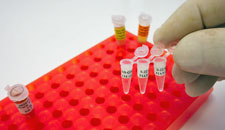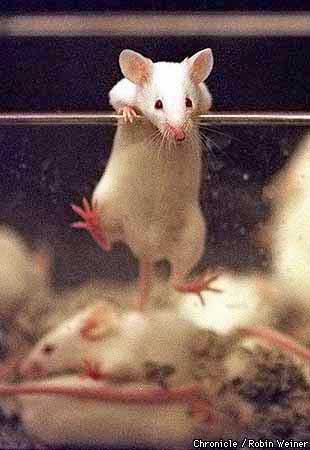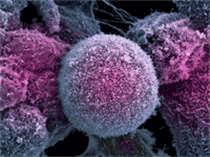 Looking back it was just another week with XMRV; a very intense one for sure, but just another up and down week for the virus that has captured our attention for the last year.
Looking back it was just another week with XMRV; a very intense one for sure, but just another up and down week for the virus that has captured our attention for the last year.Lenny Jason came up to the lunch table at the break and asked what we thought of the presentations. A bit overwhelmed by Dr. Weiss’s presentation I said “It was mostly about contamination but I thought he did well”. Lenny just replied “I wish Dr. Mikovits had been here….” And two days later there she was, just a hop away at the New Jersey CFS Conference, giving her side of things and everything seemed well again.
The Weiss Wave Hits – Dr. Weiss, a retrovirologist and author of “the Rumor Viruses”, published an editorial several weeks ago that raised the possibility that contamination could be at the source of the disparate XMRV results. In the paper he referred to his own struggle with a pathogen that seemed to be there at first and then later turned out not to be.
 The Weiss wave first picked up Dr LeGrice, who presented the XMRV overview at the meeting, and later Dr. Houghton, who presented the general overview of the first day.
The Weiss wave first picked up Dr LeGrice, who presented the XMRV overview at the meeting, and later Dr. Houghton, who presented the general overview of the first day.
Dr. LeGrice, the head of the Center of Excellence program for HIV at the NCI, was careful to leave every possibility open and indeed, it appears that every possibility is being considered, but in a sobering presentation he said he considered the issue of accidental contamination to be ‘real’ and ‘very serious’. Let’s take a look at the two sides of the contamination issue.
It’s a Contaminant– One is left ruefully mulling over the fact that the big breakthrough had to come from a mouse related virus given the propensity of mouse DNA in research labs.
- The continuing raft of negative studies appears to have shaken some researchers confidence in the original study and they have begin to publicly consider, for the first time, whether or not a contaminant slipped in.
- PCR’s are very, very powerful instruments – Dr. Coffin talked about how a PCR could detect one drop of mouse DNA in a swimming pool. Dr. LeGrice noted that one mouse cell often contains over 100 polytropic murine leukemia viruses (pMLV’s) in it. He noted that xenotropic MLV’s derived from nude mice have spread through many labs.
- When I talked with him Dr. LeGrice suggested that any step in the process is susceptible to contamination – and he noted that the heparin in test tubes and the primers and enzymes in reagents have experienced these problems. In fact, his lab has had to send back materials they discovered were contaminated. I asked him if one batch of a reagent could be contaminated while another was not and he said ‘Yes’ – every batch of reagent has to be assessed.
It’s Real! – As Dr. Mikovits has repeatedly noted, the Science paper involved a series of tests that were a check on the PCR findings. Doing those checks was the price of publication in a prestigious journal which wanted to make sure it was publishing news of a virus and not a contaminant.
Indeed, mouse contamination is a known factor which gives researchers a chance to account for it which Dr. Mikovits reported they did. She stated an internal test prior to publication indicated no mouse DNA was present but that the Science journal, which is apparently quite parsimonious in its use of print, neglected include that fact in the publication. (This isn’t the first time Science’s reluctance to shed some more black ink has bit the WPI)
Note how much needs to go wrong for the contamination theory to work out
- Test 1: the Healthy Controls – the healthy controls are always a check on contamination because if both the patients and healthy control samples are treated in a similar manner then it becomes difficult to explain how a contaminant happened to slip into one group and not the other. The samples in the two groups in the Science study were collected differently but those in the Alter/Lo and Hansen studies were not.
- Test 2: PCR Checks – Dr. Switzer of the CDC did a mtDNA and did not find evidence of contamination in the WPI’s samples. Dr. Alter specifically checked his reagants for mouse DNA and didn’t find any. Dr. LeGrice agreed Dr. Alter’s was a good test (although he would have liked a bit more power) and he would have liked one more test. Dr. Mikovits reported that the WPI searched for mouse DNA in their samples as well and came up with none.
- Test 3: The Antibody test – as Dr. Mikovits has repeated again and again a contaminant slipping into a sample cannot explain the antibody results…you can spike a blood sample with HIV from now until the cats come home and you’ll never see an antibody. Antibody tests for one virus, can, however, react to another virus so it’s possible that the positive antibody test could have picked up another closely related virus. One must ask how likely it is that ME/CFS patients would harbor another closely related virus (while healthy controls would not), and how likely that it would just happen to show up in roughly the same percentages in both the patients and the healthy controls as did the PCR test (???). Plus Dr. LeGrice noted WPI researcher Dr. Bagni’s success at finding antibodies specific to XMRV which increases the strength and validity of the antibody test. Dr. Singh is using her own antibody tests to check her results as well.
- Test 4: Growing the Virus -Dr. LeGrice laid out several different scenario’s for contamination – PCR amplicon’s, mouse DNA and a viral vector – two of which do not apply to the WPI’s results because the WPI didn’t just find a sequence – they were actually able to find and grow the virus.
- Test 5: An Infectious Virus – The WPI was able to show that dropping a XMRV negative cell into cell-free media from patient samples resulted in the cell being infected with XMRV. Again, only a virus can infect another cell – not a few bits of aberrant mouse DNA or an endogenous retrovirus. Their testing also indicated they did not find the virus when they were not supposed to (before it was dropped into the blood) and they did when they were supposed to (after it was in the blood) – suggesting that their tests are accurate
- Test 6: A Budding Virus –The WPI was able to show a virus budding from the infected cells. They weren’t able to definitively identify the virus but they were able to show that it was the appropriate size.
- Test 7:
 Sequence Variability – yes, sequence variability appeared to be low at first but that was based on only a few samples. Very low variability could suggest a contaminant but increased variability would strongly argue against that and that is what Dr. Mikovits has been reporting
Sequence Variability – yes, sequence variability appeared to be low at first but that was based on only a few samples. Very low variability could suggest a contaminant but increased variability would strongly argue against that and that is what Dr. Mikovits has been reporting - Test 8: Several MLV Experts Believe Contamination is Unlikely – The contamination theory may have some excellent retrovirologists behind it but the WPI has two experienced mouse retrovirologists (Dr. S. Ruscetti (to the right), Dr. Singh) who are well acquainted with the dangers of mouse contamination and have dealt with them for many years.
- Test 9: Consistent Results Across the Positive Tests – the percent of positive results (from 50-80%) for people with CFS and healthy controls (4-8%) has been remained roughly consistent across the studies. Furthermore, it has dropped when in less rigorously defined groups (VIP Dx – @50%) and increased in more rigorously defined groups – as would be expected. As noted, the antibody tests have shown similar results.
- Healthy controls in five studies need somehow not to get contaminated (while the patients are) AND
- Patients in the Science study (but not the controls) need to produce antibodies to a similar but different virus AND
- Contamination not by mouse DNA but an infectious virus must occur AND
- A budding virus that just happens to be the right size for XMRV needs to show up AND
- Increased sequence variability needs to be explained away (somehow) AND
- Several noted MLV experts to be wrong AND
- Consistent results across the positive studies need to be explained.
There are a lot of AND’s there. It would seem statistically unlikely for every one of these things to come to pass yet the negative studies continue to mount, there is no consensus on what has gone wrong, and the Blood Working group has resorted to looking at virtually everything; from the test tubes used to the time the blood is sitting out to the time it’s spent in the freezer to the smallest aspects of the different protocols used.
Indeed, discerning the reasons behind the disparate XMRV study results has been a challenge almost from the beginning.
A Field in Flux – Explanations for the differing results have changed over time; first it was culturing (or the lack of it), then there was APOBEC3 enzyme and the use of the wrong clones, the patient cohorts were a big question mark at one time and now there’s the blood storage issues. After the Weiss paper was published, contamination, which was hardly discussed earlier, really reared it’s head for the first time. Everyone is obviously learning as they go.
The point is that the learning curve is steep and the process has not been smooth for anyone and there’s a lot to learn. XMRV is only the third infectious human retrovirus found – is there any surprise that it would present new challenges?
The Blood Working Group is Moving ‘Quickly”
Sample Preparation Tested: Dr. LeGrice noted that a lot of things can happen in the 2-4 days before most samples get tested. Cells full of XMRV could lyse (die) for instance making the PBMC’s many studies have looked at useless. Dr. Mikovits, according to Sue at the LifeWithCFS blog, cited a litany of factors that could contribute to the negative studies at the New Jersey Conference including improper storage, using PBMC’s instead of plasma, patient selection, different methods, looking for the env sequence and more. The BWG is subjecting blood to a variety of different ways (leaving it out for different times at different temperatures, etc.) to see how it effects XMRV.
 Resolution Near? – Alter/Lo should be able, fairly quickly, to get to the bottom of that they found and Dr. LeGrice told me he expected the Blood Working Group ( BWG) to settle the contamination issue quickly – in the next three weeks, he thought. This suggests that the blood storage issues will be settled quickly as well.
Resolution Near? – Alter/Lo should be able, fairly quickly, to get to the bottom of that they found and Dr. LeGrice told me he expected the Blood Working Group ( BWG) to settle the contamination issue quickly – in the next three weeks, he thought. This suggests that the blood storage issues will be settled quickly as well.
THE Assay – The BWG has developed a very sensitive quantitative PCR assay (the same type Dr. Singh is using) called XSCA that can differentiate between endogenous MLV’s (old retroviral elements in our genome) and XMRV and this will, presumably, be the assay that tells the tale for XMRV. Several experts have stated they expect that the definitive assay for XMRV, which will also outline the proper way to store and prepare samples, to be finished by the end of December. Dr. LeGrice said all the answers, however, (whatever those are) will take six to nine months.
The National Cancer Institute Has Been Busy (NCI)
Antibody Test – The NCI is working on a wide array of tests; ELISA, DNA, Western Blot, Nucleic Acid and immunohistochemistry tests. They have also cloned, expressed and purified every protein that XMRV produces – a large project that they reportedly spent a lot of money on. Because antibodies react to proteins clarifying these proteins has laid the basis for their serological tests. Now they need to determine how many proteins a sample has to react to in order for it to be positive – a time consuming chore.
(Positive tests in the viral field are never solitary; a positive test always needs to be validated by another positive test in the final analysis. In HIV, for instance, an antibody test needs to be validated against another type of test for that result to be considered ‘positive’. Obviously we’re not that far along in XMRV yet).
DERSE – meanwhile a new test – DERSE – (Detection of Exogenous Retroviral … Elements) will permit more rapid detection of infectious XMRV particles. DERSE is not going to be a frontline diagnostic tool but it can pick up XMRV just three days after a person has been infected with it.
 Those Mysterious pMLV’s – What about those mysterious pMLV’s Alter/Lo found? Dr. LeGrice told me that Alter/Lo should be able to easily flesh out the full genetic sequences of their ‘pMLV’s – so that issue should be resolved quickly. Dr. Mikovits reported that these mysterious additions are not pMLV’s at all but HMRV’s – human-(murine-related- viruses???) (but that the WPI is still sitting on 500 isolates they don’t have the money to sequence). She also noted that XMRV is not found in mice at all; it is related to mouse murine retroviruses but is found, so far as we know, only in humans – another startling finding.
Those Mysterious pMLV’s – What about those mysterious pMLV’s Alter/Lo found? Dr. LeGrice told me that Alter/Lo should be able to easily flesh out the full genetic sequences of their ‘pMLV’s – so that issue should be resolved quickly. Dr. Mikovits reported that these mysterious additions are not pMLV’s at all but HMRV’s – human-(murine-related- viruses???) (but that the WPI is still sitting on 500 isolates they don’t have the money to sequence). She also noted that XMRV is not found in mice at all; it is related to mouse murine retroviruses but is found, so far as we know, only in humans – another startling finding.
- Check out Bob’s Blog for More on the Mouse – Human Retrovirus Connection
But why did Alter/Lo only pick up the pMLV-like sequences in their samples? We don’t know but Dr. Mikovits reported that when Dr. Ruscetti cultured Alter’s samples he found XMRV as well – which, of course, is great news because, if it is validated by another lab, it provides proof that Alter/Lo completely validated the WPI’s findings.
Dr. LeGrice also stated the NCI is asking researchers to provide details of their protocols they don’t usually provide so they can pour over them and see if small changes researchers usually don’t worry about could be making the difference. It sounds like an extraordinary effort and is probably driven by a) the excellence of the original Science paper and their inability to satisfactorily explain away the results of the following studies.
Dr. LeGrice also reported that the NCI is in contact with Dr. Lipkin at the NIAID – hopefully providing a level of collaboration rarely seen in groups studying ME/CFS at the DHHS.
Two Key Researchers
Reports that Dr. Ruscetti was able to actually isolate XMRV from Alter/Lo’s samples is a huge step forward and now it will be important for Dr. Alter to do that himself. Why? Because there’s physical separation between his lab and the NCI’s and the WPI’s and that’s what researchers want to see.
Dr. Alter’s study appears to be nearly ironclad; he and Lo were wary about contamination issues going in and accounted for them by testing their reagents for mouse DNA. Isolating the virus on top of that would appear to be hard to very hard to argue against.
Look for Dr. Alter to report on his efforts to a) determine what viruses the pMLV sequences belong to and b) the outcome of his efforts to isolate and grow the actual viruses.
Non-Infectious or Infectious Viruses? – Another big question is if the ‘pMLV’s’ (or HMRV’s) Alter/Lo found are infectious? Dr. LeGrice noted that pMLV’s have been found in virtually all mammals but no infectious pMLV, at least in humans, has been discovered to date. So far as researchers know now they appear to have lost that ability and are now passed down in the genome. Dr. Mikovits reports, however, that these are HMRV’s – not pMLV’s at all; if she’s correct then that means we’re talking about a whole entity here and you can throw the pMLV findings out the window. (Determining if they are infectious requires isolating them (using the WPI’s EXACT techniques, as she put it :)) and then seeing if they infect cells. )
The Big Studies
 Dr. Mikovits reported that they are having trouble getting their papers published; that will likely continue until XMRV’s situation is clarified. XMRV’s fate,however, has most likely been out of the WPI’s hands for quite some time – it rests on the ability of independent labs to replicate their results, and a series of big studies that either replicate or closely replicate key facets of the WPI’s study are underway.
Dr. Mikovits reported that they are having trouble getting their papers published; that will likely continue until XMRV’s situation is clarified. XMRV’s fate,however, has most likely been out of the WPI’s hands for quite some time – it rests on the ability of independent labs to replicate their results, and a series of big studies that either replicate or closely replicate key facets of the WPI’s study are underway.
The comprehensive Singh study appears to be wrapping up, the Lipkin study will use the Blood Working Groups recommendations on sample preparation, the CFIDS/Glaxo Smith Kline with its good cohort has been underway for awhile and Dr. Klimas, with her wealth of information, has been waiting for months on her results. Resolution of the most basic and pressing question: how to find XMRV and how often it shows up in CFS, appears to be in the wind.
The Treatment End
If/When XMRV is Validated – expect some real action on treatment end. Dr. LeGrice stated that the medical community has a ‘very limited cupboard’ to use against XMRV right now but that could change rapidly and he felt the NCI would be a ‘perfect fit’ for XMRV. He noted that moving the focus from HIV drugs to XMRV would be a piece of cake for his group -just a small shift in direction and he appeared eager to do that. (As the head of the Centers of Excellence program on HIV at the National Cancer Institute he works with devising treatments for HIV)
However, there are some considerations – the most significant of which is XMRV’s low replication rate. Anti-retrovirals work by blocking a retroviruses replication cycle and theoretically shouldn’t be very effective against a virus that’s not replicating much. It’s still very early days for XMRV for sure; we know that the virus replicates well in prostate cancer and epithelial cells and probably does in others as well. (It appears to be inhibited in the immune cells tested thus far by the APOBEC3 enzyme)
 The idea of a low replicating virus could quickly change if a tissue reservoir full of replicating virus was found – an issue the WPI has been working on for some time. Dr. Mikovits noted that the cells they happened to chose to look for XMRV (T and B cells) just happened to be quite poor choices (which does suggest that she knows of better choices).
The idea of a low replicating virus could quickly change if a tissue reservoir full of replicating virus was found – an issue the WPI has been working on for some time. Dr. Mikovits noted that the cells they happened to chose to look for XMRV (T and B cells) just happened to be quite poor choices (which does suggest that she knows of better choices).
Dr. LeGrice would like to be able to measure viral load before he embarks on a clinical trial and noted that third-party payers (insurance companies) will most likely not pay for antiretroviral drug until they can directly measure its effectiveness against a virus which is a shame because Dr. Klimas has immune markers she could use and researchers use quantitative scales and other lab tests all the time to measure drug effectiveness in CFS. Hemispherx, for instance, has used VO2 max in exercise tests to quantify the effects of Ampligen on CFS. It’s clear that Dr. LeGrice works in a different world than CFS researchers do.
Conclusion: XMRV’s Time Has Almost Come. If Dr. LeGrice is right, the reasons behind the disparate studies, for better for worse, will be known in the next month. Drs. Alter/Lo should be able to tell us if they found HMRV’s, pMLV’s or whatever fairly quickly. Somewhere around the end of the year the Blood Working Group will release the definitive assay for XMRV (setting off another round of testing?). The Singh study and the CAA/Glaxo Smith Kline study will hopefully be wrapped up shortly and be on their way to publication. Dr. LeGrice said six to nine months still were needed for the definitive answer to XMRV’s prevalence in CFS but it appears likely the balance will tip one way or another for XMRV long before then.

